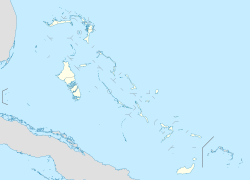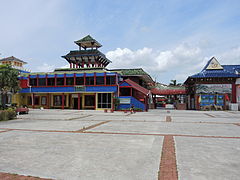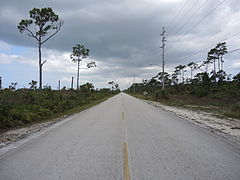City in Grand Bahama, The Bahamas
Freeport is a city, district and free trade zone on the island of Grand Bahama of the northwest Bahamas. In 1955, Wallace Groves, a Virginian financier with lumber interests in Grand Bahama, was granted 20,000 hectares (50,000 acres) of pineyard with substantial areas of swamp and scrubland by the Bahamian government with a mandate to economically develop the area. Freeport has grown to become the second most populous city in the Bahamas.
The main airport serving the city is the Grand Bahama International Airport, which receives domestic flights from various islands of the Bahamas as well as several international flights from the United States, Italy, and Canada. Freeport is also served by domestic Bahamian ferry services to other islands, and an international ferry connection to Miami.
The Grand Bahama Port Authority (GBPA) operates the free trade zone, under the Hawksbill Creek Agreement signed in August 1955 whereby the Bahamian government agreed that businesses in the Freeport area would pay no taxes before 1980, later extended to 2054.[1] The area of the land grants within which the Hawksbill Creek Agreement applies has been increased to 56,000 hectares (138,000 acres).[2]
History
Freeport is a 600 km2 (230 sq mi) free trade zone on Grand Bahama Island, established in 1955 by the government of The Bahamas. The city of Freeport emerged from a land grant comprising 20,000 hectares (50,000 acres) of swamp and scrub to become a cosmopolitan centre.
The Grand Bahama Port Authority (GBPA) operates the free-trade zone, under special powers conferred by the government under the Hawksbill Creek Agreement,[3] which was recently[when?] extended until August 3, 2054. The agreement also increased the land grants to 56,000 hectares (138,000 acres).
The city was severely impacted by Hurricane Dorian with damage still being assessed as of 12 September 2019.[4][needs update]
Geography
Freeport is located just 108 kilometres (67 mi) off the coast of Palm Beach, Florida, and on the major EW–NS shipping routes. This has positioned it as an ideal centre for international business. Consequently, a growing number of international companies use Freeport for a business site.
National parks
Parks include the Rand Nature Centre, named after its founder James Rand; Petersons Cay, a small isle about 300 yards off the shore of Grand Bahama; and the Lucayan National Park founded by Peter Barratt, a former architect and town planner of Freeport. The Lucayan National Park is 16 hectares (40 acres) in extent and includes five ecological zones stretching from the south shore to the pineyard.[5] There is an extensive underwater cave system beneath the park. One cave entrance is accessible by stairs at the national park, while other caves are accessible for certified scubas.
Climate
Freeport features a tropical rainforest climate, similar to South Florida's. According to Köppen Climate Classification (Af)[citation needed], more specifically with hot humid conditions that vary only a little throughout the year. Seldom do temperatures drop below 16 °C (60 °F). Average temperatures are around 27 °C (80 °F), with water temperature varying between 22 and 26 °C (72 and 78 °F). The winters are usually mild and dry (with the exception of some rainfall due to cold fronts), while the summers are usually hot and wet. Although a freeze has never been reported in the Bahamas, snow was reported to have mixed with rain in Freeport in January 1977, the same time that it snowed in the Miami area. The temperature was about 4.5 °C (40.1 °F) at the time.[6] The temperature of 4.5 °C (40.1 °F) was tied, on 30 January 2022.[7]
| Climate data for Freeport (1971-2000)
|
| Month
|
Jan
|
Feb
|
Mar
|
Apr
|
May
|
Jun
|
Jul
|
Aug
|
Sep
|
Oct
|
Nov
|
Dec
|
Year
|
| Mean daily maximum °C (°F)
|
24.3
(75.8)
|
24.4
(75.9)
|
25.8
(78.4)
|
27.4
(81.3)
|
29.7
(85.4)
|
31.2
(88.2)
|
32.2
(90.0)
|
32.3
(90.2)
|
31.7
(89.0)
|
29.7
(85.4)
|
27.3
(81.2)
|
25.1
(77.2)
|
28.4
(83.2)
|
| Mean daily minimum °C (°F)
|
15.9
(60.7)
|
15.6
(60.0)
|
17.5
(63.5)
|
19.2
(66.6)
|
21.1
(69.9)
|
23.2
(73.8)
|
23.9
(75.1)
|
23.9
(75.1)
|
23.3
(74.0)
|
21.4
(70.5)
|
19.4
(66.9)
|
17.0
(62.6)
|
20.1
(68.2)
|
| Average precipitation mm (inches)
|
83.1
(3.27)
|
72.6
(2.86)
|
93.5
(3.68)
|
66.8
(2.63)
|
104.7
(4.12)
|
176.0
(6.93)
|
165.4
(6.51)
|
207.8
(8.18)
|
217.4
(8.56)
|
142.8
(5.62)
|
93.0
(3.66)
|
73.7
(2.90)
|
1,496.8
(58.92)
|
| Average rainy days
|
10
|
9
|
9
|
7
|
12
|
17
|
18
|
19
|
19
|
16
|
11
|
10
|
157
|
| Mean monthly sunshine hours
|
217
|
226
|
279
|
270
|
279
|
270
|
279
|
279
|
240
|
248
|
210
|
217
|
3,014
|
| Mean daily sunshine hours
|
7
|
8
|
9
|
9
|
9
|
9
|
9
|
9
|
8
|
8
|
7
|
7
|
8
|
| Percent possible sunshine
|
65
|
71
|
75
|
70
|
67
|
65
|
66
|
69
|
65
|
70
|
65
|
67
|
68
|
| Average ultraviolet index
|
5
|
7
|
9
|
10
|
11
|
11
|
11
|
11
|
10
|
8
|
6
|
5
|
9
|
| Source 1: WMO [8]
|
| Source 2: Weather Atlas (rain days, sun, and uv)[9]
|
Economy
Tourism draws more than 1 million visitors per year, but has diminished since 2004, when major hurricanes Hurricane Frances and Hurricane Jeanne made landfall; in 2016, Hurricane Matthew hit the island. In early September 2019, Hurricane Dorian moved over the area and stalled for over a day, causing extensive devastation. Several cruise ships stop weekly at the island. Much of the tourist industry is centered on the seaside suburb of Lucaya, owing its name to the pre-Columbian Lucayan inhabitants of the island evidence of whom has been found on the island. Freeport features at least two Junkanoo festivals near New Year's.
The city is often promoted as Freeport/Lucaya. Most hotels on the island are located in Lucaya along the southern shore facing the Northwest Providence Channel. The primary shopping venue for tourists is the Port Lucaya Marketplace in Lucaya. Recovery from the 2004 Hurricanes Jeanne and Frances took nearly a decade and led to closure of the older shopping venue International Bazaar and neighboring Bahamas Princess Resort and Casino.
Twin towns – sister cities
Freeport is twin towns and sister cities with Lucaya














